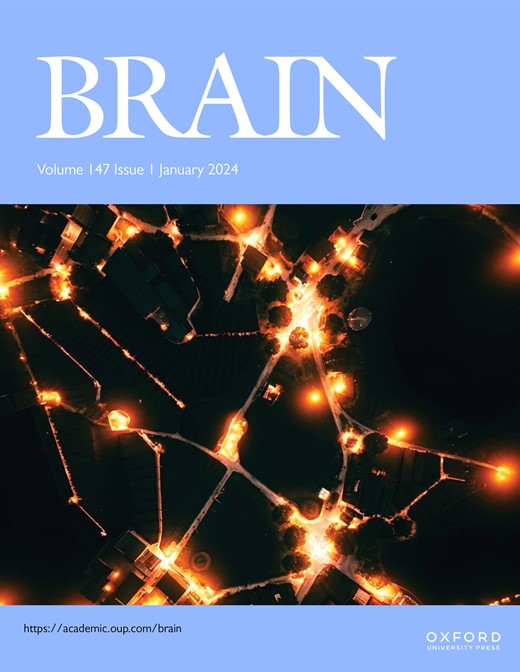Astrocytic mGluR5-dependent calcium hyperactivity promotes amyloid-β pathology and cognitive impairment.
IF 10.6
1区 医学
Q1 CLINICAL NEUROLOGY
引用次数: 0
Abstract
Astrocytic dysfunction is a crucial factor for the pathogenesis of Alzheimer's disease. Metabotropic glutamate receptor 5 (mGluR5) is ubiquitously expressed in the brain and is a key molecule that regulates synaptic transmission and plasticity. It has been shown that mGluR5 is elevated in astrocytes in Alzheimer's disease. However, it remains elusive how astrocytic mGluR5 contributes to the pathogenesis of Alzheimer's disease. Here, we first quantified a high expression level of astrocytic mGluR5 in the hippocampus of Alzheimer's disease brains and demonstrated that the expression of astrocytic mGluR5 was positively correlated with Alzheimer's disease progression in both humans and mice. Upregulating astrocytic mGluR5 in the CA1 area at an early stage accelerated, whereas downregulating these receptors rescued, Aβ pathology and cognitive impairment in Alzheimer's disease mice. Moreover, the activation of mGluR5 led to calcium hyperactivity in astrocytes, causing Aβ pathology progression due to dysregulated Aβ uptake and degradation in astrocytes. Importantly, attenuating astrocytic calcium hyperactivity in the hippocampal CA1 area in the prodromal phase ameliorated Aβ pathology and cognitive defects in Alzheimer's disease mice. Our findings thus reveal a fundamental contribution of astrocytic mGluR5 in presymptomatic Alzheimer's disease that may serve as a potential diagnostic and therapeutic target for early Alzheimer's disease pathogenesis.星形细胞mglur5依赖性钙亢进促进淀粉样蛋白-β病理和认知障碍。
星形细胞功能障碍是阿尔茨海默病发病的重要因素。代谢性谷氨酸受体5 (mGluR5)在大脑中普遍表达,是调节突触传递和可塑性的关键分子。已有研究表明,mGluR5在阿尔茨海默病的星形胶质细胞中升高。然而,星形细胞mGluR5如何参与阿尔茨海默病的发病机制尚不清楚。在这里,我们首先量化了阿尔茨海默病大脑海马中星形细胞mGluR5的高表达水平,并证明了人类和小鼠中星形细胞mGluR5的表达与阿尔茨海默病的进展呈正相关。上调CA1区域的星形细胞mGluR5在早期加速,而下调这些受体可挽救阿尔茨海默病小鼠的Aβ病理和认知障碍。此外,mGluR5的激活导致星形胶质细胞钙过度活跃,由于星形胶质细胞中Aβ摄取和降解失调,导致Aβ病理进展。重要的是,在前驱期减弱海马CA1区星形细胞钙的高活性可以改善阿尔茨海默病小鼠的Aβ病理和认知缺陷。因此,我们的研究结果揭示了星形细胞mGluR5在症状前阿尔茨海默病中的基本贡献,可能作为早期阿尔茨海默病发病机制的潜在诊断和治疗靶点。
本文章由计算机程序翻译,如有差异,请以英文原文为准。
求助全文
约1分钟内获得全文
求助全文
来源期刊

Brain
医学-临床神经学
CiteScore
20.30
自引率
4.10%
发文量
458
审稿时长
3-6 weeks
期刊介绍:
Brain, a journal focused on clinical neurology and translational neuroscience, has been publishing landmark papers since 1878. The journal aims to expand its scope by including studies that shed light on disease mechanisms and conducting innovative clinical trials for brain disorders. With a wide range of topics covered, the Editorial Board represents the international readership and diverse coverage of the journal. Accepted articles are promptly posted online, typically within a few weeks of acceptance. As of 2022, Brain holds an impressive impact factor of 14.5, according to the Journal Citation Reports.
 求助内容:
求助内容: 应助结果提醒方式:
应助结果提醒方式:


